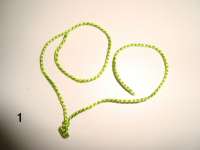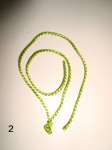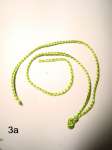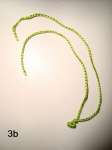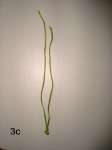No. 1 shows the involute vernation, both halves of the leaf are rolled independently. This is observed in the genus Lagenandra, but not only, what confirms the photo of Amophophallus bulbifer leaflet unfolding involutely which I sent in the prevoius message.
No. 2 is the most common type of vernation in Araceae, it was depicted in the photo of Zantedeschia leaf I sent previously. as I know a little Latin, I would call it supervolute. "Super" means "over" "above". One half of a leaf is wrapped by the other half, the internal half remains rolled until the wrapping half unfolds.
One half is rolled clockwise, the other one is rolled counter-clockwise (looking from the midrib).
No. 3a, 3b, 3c is the problem. "Con" means "together". In this case both halves are in the same roll, paralelly unfolding in the same direction by contrast to the type 2. This is what I would call convolute, I haven't observed this in aroids yet, however it is possible.
Marek
----- Original Message -----
Sent: Friday, January 15, 2010 6:04 AM
Subject: Re: [Aroid-l] Supervolute vernation. Finally a photo!
I have always thought that convolute and supervolute vernation were the same thing. That is, that the left side is wrapped around the right side, which is wrapped around itself. Or vice versa, with right around the left. Most aroids are this way.
The Pachyneurium anthuriums are involute, looking like two tubes side by side. This includes the common birdnest types, as well as some heart shaped leaves, like standleyi and watermaliense. Aren't there just these two types of vernation?
You mention that most of the plants sold as hookeri are hybrids. I think that most are true species of pachyneurium types, and if hybrids are certainly not hybrids of hookeri, but are hybrids of schlectendallii or crispamarginata or other common birdnest types.
And in your last paragraph, you write about scalariform VERnation, which should be scalariform VEnation, referring to the vein structure of the leaf. Just a typo, but confusing to the subject at hand.
shivering in south florida,
Don Bittel
________________________
Wed, 13 Jan 2010 15:02:44 -0600
From: Steve@exoticrainforest.com
To: aroid-l@gizmoworks.com
Subject: [Aroid-l] Supervolute vernation. Finally a photo!
There are several types of leaf vernation when a new leaf first emerges. Vernation is simply the way a new leaf blade is rolled or folded as it begins to emerge from the cataphyll.
Although there are several forms of vernation in aroids the most common type is known as convolute vernation which describes the edges of a newly unfurling leaf blade which have both margins (edges) curled inward wrapping around each other. This is observed when the new blade emerges from the cataphyll and the wrapping of one margin is rolled over the other. The mechanism makes the emerging leaf present itself as a tube.
The second is known as involute vernation and is observed when a newly developing leaf emerges from the cataphyll when both margins (edges) on opposing sides of the leaf blade are rolled forming two inward facing tubes that meet at the midrib of the leaf. This type is not as common as convolute vernation.
The least common is known as supervolute vernation. I have been working for weeks to complete an article for the next issue of Aroideana (the journal of the International Aroid Society) to be published in August. That article attempts to make many of the terms used in scientific literature easy for a collector to understand and use. One of the most difficult definitions to write was the one for supervolute vernation since a definition did not exist in any of the scientific texts or journals I own. I couldn't even find a definition on the internet and the definition I found on the internet for "supervolute" was impossible to understand. Look it up and see if you can figure out what they are trying to say!
Finally my friend Leland Miyano sent a photo of a newly emerging leaf of Anthurium hookeri and the definition Dr. Tom Croat helped to clarify suddenly became crystal clear. Until I received this photo I had no real idea what supervolute vernation really meant.
supervolute vernation
Possessing a convolute arrangement in the folding or arrangement of a newly emerging leaf blade with one margin (edge) of the newly blade emerging rolled inward toward the midrib and the opposite margin rolled around the midrib as well as the remainder of the leaf in a manner similar to the coiled whorl at the end of a conch shell.
My thanks to Leland for the photo!
If you believe you are growing Anthurium hookeri you may want to look at this page! I have been trying to find a specimen for years and so far have never been able to buy one since all the plants available for sale are not the species but instead are a hybrid.
If the plant doesn't have scalariforme (ladder-like) vernation, glandular punctates (tiny black spots) on the back of the leaf, and produces white berries on an inflorescence instead of the read ones everyone believes the species should produce it isn't the real Anthurium hookeri.
http://www.exoticrainforest.com/Anthurium%20hookeri%20pc.html
Steve
www.ExoticRainforest.com
Hotmail: Trusted email with powerful SPAM protection. Sign up now.
_______________________________________________
Aroid-L mailing list
Aroid-L@www.gizmoworks.com
http://www.gizmoworks.com/mailman/listinfo/aroid-l
Nie znaleziono virusa w tej wiadomosci przychodzacej.
Sprawdzone przez AVG - www.avg.com
Wersja: 8.5.432 / Baza danych wirus=F3w: 270.14.141/2622 - Data wydania: 01/14/10 19:35:00
------=_NextPart_001_0164_01CA96C3.C42DDE90--------=_NextPart_000_0163_01CA96C3.C42DB780


